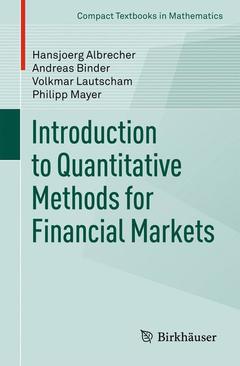Description
Introduction to Quantitative Methods for Financial Markets, 2013
Compact Textbooks in Mathematics Series
Language: German
Subject for Introduction to Quantitative Methods for Financial Markets:
191 p. · 15.5x23.5 cm · Paperback
Description
/li>Contents
/li>Biography
/li>Comment
/li>
Swaps, futures, options, structured instruments - a wide range of derivative products is traded in today's financial markets. Analyzing, pricing and managing such products often requires fairly sophisticated quantitative tools and methods. This book serves as an introduction to financial mathematics with special emphasis on aspects relevant in practice. In addition to numerous illustrative examples, algorithmic implementations are demonstrated using "Mathematica" and the software package "UnRisk" (available for both students and teachers). The content is organized in 15 chapters that can be treated as independent modules.
In particular, the exposition is tailored for classroom use in a Bachelor or Master program course, as well as for practitioners who wish to further strengthen their quantitative background.
Hansjoerg Albrecher is Professor of Actuarial Science at the Faculty of Business and Economics, University of Lausanne, as well as a Faculty Member of the Swiss Finance Institute. Previous affiliations include the Johann Radon Institute for Computational and Applied Mathematics of the Austrian Academy of Sciences in Linz, the University of Linz, the University of Aarhus, K.U. Leuven and Graz University of Technology. The author has ample experience in connecting the academic world with practitioners' views and problems, and has been advising banks and insurance companies.
Andreas Binder is CEO of MathConsult GmbH and head of MathConsult's computational finance group, who have been developing the UnRisk® software suite for valuation and risk management of financial instruments. He is an experienced adviser of banks, auditors, regulators and capital management firms.
Volkmar Lautscham has graduated in Technical Mathematics and Financial/Industrial Management from Graz University of Technology and Karl-Franzens University, respectively, with longer academic stays abroad in Sheffield, London and Stockholm. From 2006 to 2009, he was working for a major investment bank in London focusing on credit underwriting/structuring and real estate. The author currently holds a position at the University of Lausanne, where he pursues a PhD degree and teaches within the MSc Actuarial Science programme.
Philipp Mayer obtained his PhD in financial mathematics from Graz University of Technology. He then held amongst others a post-doc position at the Radon Institute of the Austrian Academy of Sciences in Linz, before returning to Graz as an assistant professor, where he carried out research in financial mathematics and taught both bachelor and master level courses. In 2010 he joined the Financial Markets department of a major financial institution in Brussels, where he is responsible for modeling equity, commodity and hybridinstruments.



